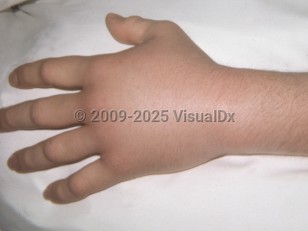Lizard envenomation
Alerts and Notices
Important News & Links
Synopsis

The Gila monster (Heloderma suspectum) is the only venomous lizard species native to the United States. This large lizard inhabits the desert regions of Arizona, western New Mexico, southeastern California, the southern tip of Nevada, extreme southwestern Utah, and northwestern Mexico. It has a heavy body, large head, and grows to about 50 cm (20 inches) long. Gila monsters have powerful jaws with venom glands in their anterior lower jaw region. When the lizard bites, venom is released into the victim's tissue.
Gila monster venom contains a variety of components including L-amino acid oxidase, hyaluronidase, phospholipase A, serotonin, and highly active kallikreins that release vasoactive kinins. The degree of envenomation correlates directly with how long the Gila monster remains attached to the victim. There have been no documented deaths in healthy humans bitten by Gila monsters in the United States.
Most Gila monster bites involve captive specimens. At the wound site, there may be multiple lacerations that can bleed profusely, edema, vasospasm with cyanosis, ecchymosis, and/or retained teeth. Victims may complain of severe burning or throbbing pain that can last hours and radiate proximally.
Systemic symptoms include generalized weakness, nausea, vomiting, diaphoresis, tachycardia, hypotension, shortness of breath, lightheadedness, angioedema, lymphangitis, and lymphadenopathy.
Rare hypersensitivity to Gila monster venom has been reported.
Gila monster venom contains a variety of components including L-amino acid oxidase, hyaluronidase, phospholipase A, serotonin, and highly active kallikreins that release vasoactive kinins. The degree of envenomation correlates directly with how long the Gila monster remains attached to the victim. There have been no documented deaths in healthy humans bitten by Gila monsters in the United States.
Most Gila monster bites involve captive specimens. At the wound site, there may be multiple lacerations that can bleed profusely, edema, vasospasm with cyanosis, ecchymosis, and/or retained teeth. Victims may complain of severe burning or throbbing pain that can last hours and radiate proximally.
Systemic symptoms include generalized weakness, nausea, vomiting, diaphoresis, tachycardia, hypotension, shortness of breath, lightheadedness, angioedema, lymphangitis, and lymphadenopathy.
Rare hypersensitivity to Gila monster venom has been reported.
Codes
ICD10CM:
T63.121A – Toxic effect of venom of other venomous lizard, accidental, initial encounter
SNOMEDCT:
78920009 – Poisoning due to lizard venom
T63.121A – Toxic effect of venom of other venomous lizard, accidental, initial encounter
SNOMEDCT:
78920009 – Poisoning due to lizard venom
Look For
Subscription Required
Diagnostic Pearls
Subscription Required
Differential Diagnosis & Pitfalls

To perform a comparison, select diagnoses from the classic differential
Subscription Required
Best Tests
Subscription Required
Management Pearls
Subscription Required
Therapy
Subscription Required
References
Subscription Required
Last Updated:02/20/2018
Lizard envenomation

